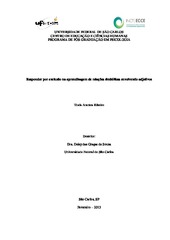| dc.contributor.author | Ribeiro, Thaís Arantes | |
| dc.date.accessioned | 2016-06-02T20:30:55Z | |
| dc.date.available | 2013-04-23 | |
| dc.date.available | 2016-06-02T20:30:55Z | |
| dc.date.issued | 2013-02-25 | |
| dc.identifier.citation | RIBEIRO, Thaís Arantes. Learning symbolic relations (word-qualifiers) by exclusion. 2013. 100 f. Dissertação (Mestrado em Ciências Humanas) - Universidade Federal de São Carlos, São Carlos, 2013. | por |
| dc.identifier.uri | https://repositorio.ufscar.br/handle/ufscar/6039 | |
| dc.description.abstract | Exclusion responding has been considered one of the processes by which children learn to relate new words to objects. This pattern of responding is usually tested with a matching to sample task. The goal of the present experiment was to verify if exclusion responding also occurs with properties-object relations: dictated model stimuli were adjectives (/happy/, /sad/ and /anger/) and comparison stimuli were properties of objects (dolls facial expression). A second goal was to investigate the relation between the quantity of exclusion trials and a learning outcome. Phase 1 established a baseline of auditory-visual discriminations in a natural situation with dolls; Phase 2 established the baseline among dictated words and pictures of the doll (a girl) with a specific software presented with a notebook; Phase 3 consisted of exclusion probes in which the pseudo words /piva/ and /fobam/ were presented as models in different trials and a defined face (related to baseline words), an undefined face (not related to baseline words) and a mask (blank comparison) were presented as comparison. Selection of undefined face showed exclusion control. Phase 3 also consisted of presentation of learning probes. In Phase 4 experimental blocks presented as comparison stimuli figures of another doll (boy) expressing the same emotions of the doll of Phase 3. The purpose of Phase 4 was to evaluate generalization of the results obtained in Phase 3. Experiment was finished if the participant had responded correctly the three learning probes or if he or she had been exposed to 10 exclusion trials with each relation. Data was collected with 22 typically developing preschool children between 24 and 29 months of age. All participants responded by exclusion along the experiment. 11 of the 22 participants showed a learning outcome, responding correctly the three learning probes (100% of correct responses) with one of the taught relations in Phase 3 or with one of the tested relations in Phase 4. Data confirm and extend regularity of exclusion responding. The amount of exclusion trials necessary to obtain a learning outcome and the best learning probes to be used still needs to be investigated. | eng |
| dc.description.sponsorship | Universidade Federal de Minas Gerais | |
| dc.format | application/pdf | por |
| dc.language | por | por |
| dc.publisher | Universidade Federal de São Carlos | por |
| dc.rights | Acesso Aberto | por |
| dc.subject | Psicologia experimental | por |
| dc.subject | Aprendizagem relacional | por |
| dc.subject | Responder por exclusão | por |
| dc.subject | Aquisição de vocabulário | por |
| dc.subject | Mapeamento rápido | por |
| dc.subject | Crianças | por |
| dc.subject | Relational learning | eng |
| dc.subject | Vocabulary acquisition | eng |
| dc.subject | Exclusion | eng |
| dc.subject | Fast mapping | eng |
| dc.subject | Children | eng |
| dc.title | Responder por exclusão na aprendizagem de relações simbólicas envolvendo adjetivos | por |
| dc.title.alternative | Learning symbolic relations (word-qualifiers) by exclusion | eng |
| dc.type | Dissertação | por |
| dc.contributor.advisor1 | Souza, Deisy das Graças de | |
| dc.contributor.advisor1Lattes | http://lattes.cnpq.br/4404800720856419 | por |
| dc.description.resumo | O responder por exclusão é considerado um dos processos pelos quais as crianças aprendem a relacionar palavras novas a objetos. A tarefa experimental típica é a de escolha de acordo com o modelo. Este estudo teve como objetivo verificar se o responder por exclusão ocorre no ensino de relações palavra-qualidade (adjetivos): os estímulos modelo ditados eram adjetivos (/feliz/, /triste/, /brava/) e os estímulos de comparação visuais eram faces estilizadas de um fantoche. Verificou-se também a relação entre a quantidade de tentativas de exclusão e a aprendizagem de novas relações palavra-qualidade. A Fase 1 consistiu no estabelecimento da linha de base de discriminações auditivo-visuais em uma situação natural. Na Fase 2, a linha de base foi estabelecida em um computador portátil. A Fase 3 consistiu na apresentação de tentativas de exclusão em que duas pseudopalavras /piva/ e /fobam/ eram ditadas como modelos em diferentes tentativas. Os estímulos de comparação eram uma face definida (relacionada à linha de base), uma face indefinida (não relacionada à linha de base) e um estímulo comparação vazio (máscara). A seleção da face indefinida evidenciaria o controle por exclusão. Durante a Fase 3 foram apresentadas também sondas de aprendizagem. Na Fase 4, os blocos experimentais apresentavam como estímulos de comparação bonecos do sexo masculino com as mesmas expressões faciais das do fantoche da Fase 3. Essa fase teve como objetivo verificar a generalização do padrão comportamental dos participantes na fase anterior. O procedimento era finalizado caso o participante acertasse as três sondas de aprendizagem ou após o máximo de 10 tentativas de exclusão com cada relação. Os participantes, 22 crianças pré-escolares, com desenvolvimento típico e idades entre 24 e 29 meses, responderam por exclusão em praticamente todas as sondas ao longo do experimento. Desses, 11 apresentaram desempenho correspondente com aprendizagem em pelo menos uma das novas relações ensinadas na Fase 3 e avaliadas na Fase 4. Os dados confirmam e estendem a regularidade do responder por exclusão. A quantidade de exposição a tentativas de exclusão necessárias para assegurar aprendizagem e a validade dos tipos de sondas de aprendizagem ainda devem ser verificadas experimentalmente. | por |
| dc.publisher.country | BR | por |
| dc.publisher.initials | UFSCar | por |
| dc.publisher.program | Programa de Pós-Graduação em Psicologia - PPGPsi | por |
| dc.subject.cnpq | CIENCIAS HUMANAS::PSICOLOGIA | por |
| dc.contributor.authorlattes | http://lattes.cnpq.br/7525730437706871 | por |
